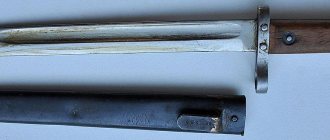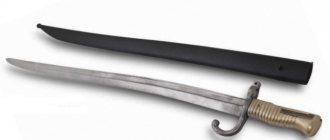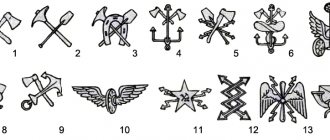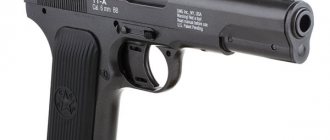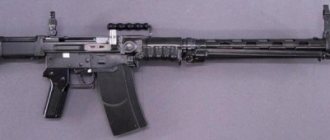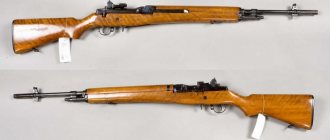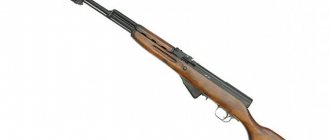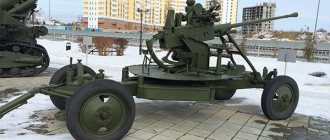Home | Weapons | Self-loading rifles | Russia / USSR | ABC-36
Simonov AVS-36 automatic rifle Photo relics-citadel.ru
7.62 mm automatic rifle of the Simonov system, model 1936, ABC-36 (GAU Index - 56-A-225) is a Soviet automatic rifle developed by gunsmith Sergei Simonov. It was originally developed as a self-loading rifle, but during improvements a burst firing mode was added for use in an emergency. The first automatic rifle developed in the USSR and put into service. It also became the world's first self-loading rifle to be put into service, beating the American M1 Garand by several months.
The first ABC model was presented by S. G. Simonov at the beginning of 1926. In April 1926, the Artillery Committee, having examined the proposed project, came to the conclusion that it could not be approved for testing.
After the 1930 competition, the greatest successes in the design of automatic rifles were achieved by Simonov and F.B. Tokarev. Continuing to work on improving the ABC, in 1931 Simonov created a new model.
Simonov's ABC-36 automatic rifle has successfully passed field tests. It was decided to produce an experimental batch and conduct extensive military tests. At the same time, it was proposed to accelerate the development of the technological process in order to launch a batch of ABC-36 into production already in the first quarter of 1934, and from the beginning of the second half of the year to prepare for gross production. To assist in organizing the production of Simonov automatic rifles, the designer himself was sent to Izhevsk.
On March 22, 1934, the Defense Committee adopted a resolution on the development in 1935 of capacities for the production of automatic rifles of the Simonov system.
As a result of a series of tests that took place in 1935-1936, the Simonov automatic rifle showed better results compared to the Tokarev model. And although some copies failed prematurely, as the commission noted, the reason for this was mainly manufacturing defects, not design. “Confirmation of this,” as stated in the test site protocol in July 1935, “can be the first prototypes of the ABC, which withstood up to 27,000 shots and did not have the kind of breakdowns that were observed in the tested samples.”
In 1936, the Simonov automatic rifle (ABC-36) was adopted by the Red Army. ABC-36 became the first automatic rifle to enter service with the Red Army after the Fedorov assault rifle. It differed from the original model proposed by the designer in 1931 in the following ways: a muzzle brake was installed, the configuration of individual parts was changed, the method of attaching the bayonet was made, and some other changes were made.
ABC-36 automatic rifles were first shown at the May Day parade in 1938; they were armed with soldiers of the 1st Moscow Proletarian Rifle Division.
On February 26, 1938, the director of the Izhevsk arms plant, A.I. Bykhovsky, reported that the automatic rifle of the Simonov system was mastered at the plant and put into mass production.
Subsequently, ABC-36 was replaced in production by SVT-38. As the People's Commissar of Armaments B.L. Vannikov recalled, Stalin demanded the creation of a self-loading rifle, from which automatic fire would be excluded, since in battle conditions aimless continuous shooting is possible, leading only to the irrational consumption of a large number of cartridges.
History of creation
7.62 mm automatic rifle of the Simonov system, model 1936, ABC-36 (GAU Index - 56-A-225) is a Soviet automatic rifle developed by gunsmith Sergei Simonov. It was originally developed as a self-loading rifle, but during improvements a burst firing mode was added for use in an emergency.
First model
The first model of an automatic rifle was presented by S. G. Simonov at the beginning of 1926. In April 1926, the Artillery Committee of the Main Artillery Directorate, having examined the proposed rifle project, came to the conclusion that it could not be allowed for testing.
After the 1930 competition, the greatest successes in the design of automatic rifles were achieved by Simonov and F.V. Tokarev. Continuing to work on improving the rifle, in 1931 Simonov created a new model.
Links[edit]
- https://www.forgottenweapons.com/early-semiauto-rifles/simonov-avs-36/ . "The AVS-36 was produced in relatively small numbers (35,000-65,000, depending on which source you want to believe)"
- ^ ab David Naumovich Bolotin (1995). John Walter; Heikki Pohjolainen] (ed.). Soviet small arms and ammunition
. Translation by Igor Fedorovich Naftulev. Hyvinkää: Finnish Arms Museum Foundation (Suomen asemuseosäätiö). pp. 104–105. ISBN 9519718419. - Another Siminov: AVS-36 – historicalfirearms.info
- ↑
David Naumovich Bolotin (1995).
John Walter; Heikki Pohjolainen] (ed.). Soviet small arms and ammunition
. Translation by Igor Fedorovich Naftulev. Hyvinkää: Finnish Arms Museum Foundation (Suomen asemuseosäätiö). paragraph 108. ISBN 9519718419. - Philip Jowett; Raffaele Ruggeri (2012). Finland in the war of 1939-45. Osprey Publishing. paragraph 48. ISBN 978-1-78200-125-6.
- Bair Irincheev (2012). The War of the White Death: Finland versus the Soviet Union 1939-40. Stackpole Books. n. colored plates after item 40. ISBN 978-0-8117-1088-6.
- ↑
US Ordnance Corps (1954).
Soviet rifles and carbines - identification and operation
. paragraph 40. - David Campbell (2016). Finnish soldier versus Soviet soldier: Winter War 1939–40
. Fight 21. Illustrated by Johnny Shumate. Osprey Publishing. paragraph 66.
ABC36 circuit
At the same time, it was proposed to accelerate the development of the technological process in order to launch a batch of rifles into production already in the first quarter of 1934, and from the beginning of the second half of the year to prepare for gross production.
To assist in organizing the production of rifles at the Izhevsk plant, the designer himself was sent to Izhevsk.
On March 22, 1934, the Defense Committee adopted a resolution on the development in 1935 of capacities for the production of automatic rifles of the Simonov system.
This barrel locking design, first implemented by Simonov in weapons of this class, made it possible to rationally distribute the load on the locking unit at the moment of firing and, consequently, reduce the weight of the bolt and the entire rifle. The striker-type trigger mechanism allows for both single and continuous fire. The flag-type translator is located in front of the trigger guard. The safety device against accidental shots is mounted in the rear of the trigger guard and supports the trigger. The return spring is located in the removable receiver cover. Extraction and reflection of the spent cartridge case is carried out by a spring-loaded ejector located in the upper part of the bolt frame and a reflector attached to the bottom of the receiver. The cartridges are fed from a detachable box magazine with 15 cartridges, arranged in a checkerboard pattern. The magazine can be loaded without removing the magazine. When the cartridges are used up, the bolt is delayed by a stop pulled out by the magazine feeder, and the system remains open for subsequent loading. The sight is a sector type and allows firing up to 1500 m. For bayonet fighting, the rifle is equipped with a folding needle tetrahedral bayonet. Simonov's automatic rifle successfully passed field tests. It was decided to produce an experimental batch of rifles and conduct extensive military tests. At the same time, it was proposed to accelerate the development of the technological process in order to launch a batch of rifles into production already in the first quarter of 1934, and from the beginning of the second half of the year to prepare for gross production. (TsGASA, f. 20, on. 19. d. 144, l. 71.) To assist in organizing the production of Simonov rifles, the designer himself was sent to Izhevsk. (Archive of the Izhevsk Machine-Building Plant, op. 16, d. 119, l. 40.)
Uncle Ian shows a fulauto on an ABC36 rifle
As a result of a series of tests that took place in 1935-1936, the Simonov automatic rifle showed better results compared to the Tokarev model. And although some copies failed prematurely, as the commission noted, the reason for this was mainly manufacturing defects, not design. “Confirmation of this,” as stated in the test site protocol in July 1935, “can be the first prototypes of the ABC, which withstood up to 27,000 shots and did not have the kind of breakdowns that were observed in the tested samples.”
In 1936, the Simonov automatic rifle (ABC-36) was adopted by the Red Army and became the first automatic rifle to enter service with the Red Army after the Fedorov assault rifle. It differed from the original model proposed by the designer in 1931 in the following ways: a muzzle brake was installed, the configuration of individual parts was changed, the method of attaching the bayonet was made, and some other changes were made.
The interior of the massive muzzle brake of the ABC 36 rifle
Muzzle brake ABC 36 with the stamp “8 in a diamond”
In 1937, ABC-36 participated in the next comparative tests of self-loading rifles for the Red Army, in which it showed slightly worse results than the prototype of the Tokarev self-loading rifle, although in terms of the totality of tactical, technical and production indicators it had some advantages over the SVT.
ABC-36 automatic rifles were first shown at the May Day parade in 1938; they were armed with soldiers of the 1st Moscow Proletarian Rifle Division.
On February 26, 1938, the director of the Izhevsk arms plant, A. I. Bykhovsky, reported that the automatic rifle of the Simonov system was mastered at the plant and put into mass production.
As the People's Commissar of Armaments B.L. Vannikov recalled, in the pre-war years, and especially since 1938, I.V. Stalin supported the decision to rearm the Red Army with a self-loading rifle rather than an automatic rifle, based on considerations of more rational use of ammunition in battle conditions .
During the Finnish war of 1939-1940. On one of the ABC-36 rifles, the spring that fed the cartridge from the magazine into the receiver broke. Experts who went to the front established that the spring did not burst under combat conditions (the rifle was hanging at the entrance to the room in the cold of -40° C). It was later found that the spring steel used in the production of the spring at a temperature of −40° lost strength by 20–30%, and at a temperature of −60° the loss of strength was almost 50%. Experimentally over the course of several days, it was determined that it was necessary to change the grade of steel used, adding a small percentage of nickel and a little vanadium. Subsequently, based on the results of a discussion of the issue with military experts, it was decided to stop the production of the ABC-36, replacing it in production with the SVT self-loading rifle.
| Type | automatic rifle |
| A country | USSR |
| Service history | |
| Adopted | 1936 |
| Wars and conflicts | Battles at Khalkhin Gol, Soviet-Finnish War, World War II |
| Production history | |
| Constructor | Simonov, Sergey Gavrilovich |
| Designed by | 1936 |
| Manufacturer | Izhmash |
| Total issued | 35-65 thousand |
| Characteristics | |
| Weight, kg | 3,8 |
| Length, mm | 1230 |
| Barrel length, mm | 612 |
| Cartridge | 7.62×54 mm R |
| Caliber, mm | 7,62 |
| Work principles | removal of powder gases, wedge locking |
| Rate of fire, rounds/min | 800 |
| Initial bullet speed, m/s | 840 |
| Type of ammunition | box-shaped, detachable magazine for 15 rounds |
ABC is an automatic weapon, built on the removal of powder gases, and can conduct both single and automatic fire. The fire mode switch is located on the receiver on the right side. The main fire mode was single. It was supposed to fire in short bursts when there were insufficient numbers of light machine guns, and continuous fire only as a last resort, when repelling sudden enemy attacks at a distance of no more than 150 meters.
Magazine for the ABC36 rifle
At the same time, it was forbidden to use more than 4 magazines in a row, so as not to overheat and wear out the barrel and other parts. According to the instructions, the ABC fire mode translator was locked with a special key kept by the squad commander, who only if necessary could allow some of the soldiers to fire in bursts (whether this function of the rifle was used in practice is a controversial issue; however, it is curious that the Fedorov 1916 assault rifle The fire translator was issued to the shooter only after passing a kind of exam.
author:US Air Force from USA - M14 Stand-off Munitions Disruptor (SMUD)
During the Vietnam War, American officers in the same way removed the translator mechanism from the M14 automatic rifles of their soldiers in order to disable the possibility of firing in bursts, which, as in the case of ABC, was practically useless when shooting hand-held) (source?). It was recommended to conduct automatic fire from a prone position from a rest, with the same butt as when firing from a light machine gun. When firing single shots, sitting or standing, it is recommended to hold the rifle with your left hand by the magazine below.
The automatic rifle has a technical rate of fire of about 800 rounds per minute. The practical rate of fire during aimed shooting is significantly lower than the technical rate. A well-trained shooter with magazines pre-filled with cartridges can produce: about 20-25 hpm with single fire (at a distance of up to 400 m), 40-50 hpm in bursts of 3-5 shots (up to 300 m), 70- 80 rpm continuous fire (up to 100-150 m).
A gas outlet unit with a short stroke of the gas piston is located above the barrel. The barrel was locked using a vertical block (wedge), which moved in the grooves of the receiver (in fact, the line of movement of the wedge had a small, about 5°, angle with the vertical, which was done to facilitate unlocking the bolt manually). When the block moved upward under the action of a spring (during manual reloading) or a special bevel of the bolt frame (during firing), it entered the grooves of the bolt, locking it. Unlocking occurred after a special clutch, which was connected to the gas piston, squeezed the locking block down from the bolt grooves.
Since the locking block was located between the breech of the barrel and the magazine, the trajectory of feeding cartridges into the chamber was quite long and steep, which served as a source of delays when firing. In addition, this led to the fact that the receiver was complex in design and had a large length. The design of the ABC bolt was also very complex, since a firing pin with a mainspring, separate parts of the trigger mechanism, and a special anti-rebound device were placed inside it. Automatic rifles manufactured before 1936 differ in the cut-off device, trigger mechanism and mainspring stop.
The rifle was fed from detachable magazines of the original sickle shape (due to the presence of a protruding rim on the cartridge used), each containing 15 rounds. Magazines could be equipped either separately from the rifle or directly on it, with the bolt open, from three standard clips for the rifle mod. 1891/30. Rifles manufactured before 1936 have magazines for 10 and 20 rounds.
The rifle barrel had a massive muzzle brake and a bayonet mount. On early issues of ABC, the bayonet could be attached not only horizontally, but also vertically, with the blade down. In this position it was supposed to be used as a one-legged ersatz bipod for shooting from a rest. However, the corrected description of the rifle, already published in 1937, categorically prohibits this, ordering instead automatic fire from a prone position from a rest in the form of a roll or turf. It also states that from the second half of 1936, they stopped equipping rifles with a bipod bayonet. Obviously, this idea, which looks attractive in theory, has not justified itself in practice. In the stowed position, the bayonet was carried in a sheath on the fighter’s belt and when firing, unlike the rifle mod. 1891/30, not adjacent. The open sight was notched at a range from 100 to 1,500 meters in 100-meter increments.
Main characteristics:
Weight of an automatic rifle with a bayonet (in sheath), with an optical sight and a magazine filled with cartridges: about 6.0 kg Weight of an automatic rifle without a bayonet, without an optical sight (with bracket) and without a magazine: 4.050 kg Weight of a magazine with 15 rounds: 0.675 kg Weight of magazine without cartridges: 0.350 kg Weight of bayonet with scabbard: 0.550 kg Weight of optical sight with bracket: 0.725 kg Weight of bracket without optical sight: 0.145 kg Weight of moving parts (bolt, rod and cocking coupling): 0.500 kg Magazine capacity: 15 rounds Caliber: 7.62 mm Overall length of the automatic rifle
- without bayonet: 1260 mm
- with bayonet: 1520 mm
Length of the rifled part of the barrel: 557 mm Number of rifling: 4 Length of the sighting line on 1/15 sights: 591/587 mm Front sight height: 29.84 mm Bolt stroke length: 130 mm Sighting range: 1500 m Maximum bullet range: up to 3 km Initial speed (at the muzzle) of a light bullet: 840 m/s Technical rate of fire: about 800 rounds per minute
Characteristics of the 1931 model optical rifle sight:
- magnification: 4x;
- field of view: 5°30′;
- exit pupil diameter: 7.6 mm;
- eye relief from the last eyepiece lens: 85 mm.
After the adoption of Simonov automatic rifles, their production, previously produced in separate batches, increases noticeably.
So, if in 1934 106 rifles were produced, and in 1935 - 286, then in 1937 - already 10,280, and in 1938 - 23,401 units. Production of the ABC-36 ceased in 1940, with a total of 65,800 produced.
Options and modifications
- ABC-36
- ABC-36 with optical sight PE mod. 1931 - sniper version, developed in 1936, released in small quantities. Since spent cartridges are thrown up and forward from the receiver, the optical sight bracket was attached to the receiver to the left of the weapon's axis. The optical sight had a sighting reticle consisting of two horizontal threads and one vertical.
Sniper option
The ABC-36 was extremely rarely used as a sniper weapon. A PE optical sight was attached to the rifle. At the moment, only isolated cases of using the ABC-36 as a sniper weapon are known. For example, the Central Museum of the Armed Forces of the Russian Federation houses the sniper rifle of Gennady Vasilyevich Androsov. This is a reward weapon.
ABC-36 on a poster. (Pinterest)
On the butt of the ABC-36 there is a metal plate with the inscription: “To the fearless fighter of fascists, ml. Lieutenant G.V. Androsov. From the Military Council of the 30th Army 12/1−43.” In total, this sniper accounted for more than 200 enemy soldiers and officers. In the award list of G.N. Androsov, Fr.
The following is an excerpt from “Stories about Small Arms”
I.P. Pastukhov, S.E. Plotnikov DOSAAF Publishing House, 1983.
In the Soviet Union, increased attention was paid to the creation of an automatic rifle during the interwar period. This is evidenced by three competitions for the best design of weapons of this type and a large number of samples submitted for testing. Leading Soviet gunsmiths and then little-known young designers took part in the competitions. Tests in 1926, 1928 and 1930 did not give an advantage to any of the models involved. All of them had design flaws, and when firing there were delays and breakdowns. The young designer S. G. Simonov coped better than others with the task of automating reloading and firing a shot. In 1931, he created a rifle, the principle of automation of which was based on the removal of powder gases through a side hole in the barrel. For the first time in weapons of this class, the barrel bore was locked with a wedge that moved in the vertical grooves of the receiver. The cartridges were fed from a detachable magazine that held 15 cartridges.
The aimed fire range was 1500 m. S. G. Simonov’s rifle was approved by the commission. Its production took place at one of the weapons factories. The designer, however, continued to improve his brainchild. As a result, a muzzle brake appeared on the barrel, which reduced recoil; the tetrahedral bayonet was replaced by a bladed one, the use of which allowed it to be rotated in relation to the rifle by 90? and use as an additional support when shooting in automatic mode. In 1936, the Simonov ABC-36 automatic rifle was finally adopted by the Red Army.
Improved technology has enabled the rapid expansion of production of these powerful and advanced weapons. Until 1938, 35,113 ABC-36s were produced. In 1939-1940, the rifle was used during the Soviet-Finnish armed conflict. Practical shooting and experience in using ABC in combat conditions revealed insufficient combat accuracy in continuous fire mode. The stability of the weapon in this case was insufficient, and the spread of bullets was quite large. Essentially, only the first shot in the line was aimed. All this, ultimately, decided the fate of the so-called self-firing, burst-firing rifles.
The attention of many of our gunsmiths has focused on a self-loading rifle, which requires pressing the trigger to fire each shot. Such a weapon, with a rate of fire of up to 25 rounds/min, well solved the problem of increasing the rate of fire while maintaining combat accuracy close to that of a non-automatic rifle. From August 25 to September 3, 1938, competitive tests of self-loading rifles by F.V. Tokarev, N.V. Rukavishnikov, S.G. Simonov and other designers took place. The best weapon was F.V. Tokarev. Under the name “7.62-mm self-loading rifle of the Tokarev system arr. 1938 (SVT-38) "It was adopted by the troops on February 26, 1939.
The Simonov rifle, competing with the SVT, which in some respects was even superior to its rival, was let down by an annoying flaw: tests revealed low survivability of the firing pin and ejector. And although S.G. Simonov completely eliminated the shortcomings of his brainchild in January 1939, the SVT-38 still went into production. The use of the rifle by the troops caused some complaints. Soldiers complained about its bulkiness, heavyness, and sensitivity to contamination. Subsequently, F.V. Tokarev made significant changes to the rifle.
It became shorter and lighter. The modernization also affected production technology, which somewhat reduced production costs and made the weapon cheaper. On April 13, 1940, the modernized self-loading rifle of F.V. Tokarev, abbreviated as SVT-40. was adopted by the Red Army. After minor modifications and installation of the PU optical sight bracket, the SVT-40 sniper version was delivered to the troops. Arms factories were involved in the production of self-loading rifles of the Tokarev system of the 1940 model.
Production increased quickly. In 1941 alone, 1,031,861 SVT-40 and 34,782 self-loading rifles equipped with optics left the factory floors. In addition to the standard ABC-36. SVT-38 and SVT-40 in the USSR in the pre-war years, several types of automatic and self-loading carbines were developed for a regular rifle and even pistol cartridge. Unfortunately, by the beginning of the Great Patriotic War, it was not possible to create an automatic carbine suitable for difficult army service. Most of the designed samples did not make it past the experimental stage. However, design discoveries tested in metal in these systems ensured success.
Research into light infantry automatic weapons in the Soviet Union was put on a scientific basis. The breadth of engineering research, the involvement of a large group of designers, and the competitive system for selecting the most complete samples have placed our country among the first in equipping troops with automatic rifles. Many authoritative weapons experts spoke highly of the good combat capabilities of the ABC-36 and SVT-40. While large-scale work was underway in the USSR in the field of individual automatic weapons, their combat capabilities were not always correctly assessed abroad. This explains the presence of single samples of self-loading rifles that entered service with foreign armies. Not in all countries the industry was prepared for the production of auto rifles, the parts of which had low technical tolerances and required high cleanliness of finish. States whose armies could not be supplied with these weapons from domestic factories switched to the practice of ordering automatic rifles abroad.
Source:
I.P. Pastukhov, S.E. Plotnikov “Stories about small arms” DOSAAF Publishing House, 1983
Text source: https://ru.wikipedia.org/wiki/%D0%90%D0%B2%D1%82%D0%BE%D0%BC%D0%B0%D1%82%D0%B8%D1% 87%D0%B5%D1%81%D0%…
Grade
In general, the Simonov rifle turned out to be difficult to manufacture and not reliable enough for mass use among the troops. ABC had a very complex design and many complex-shaped parts, the production of which required high qualifications and a lot of time and resources. The design made it possible to assemble the rifle without a locking block and then fire a shot; if this happened by mistake of the shooter, the receiver was destroyed, the bolt group flew back and injured the shooter.[7]. The original wedge locking did not pay off either. The survivability of the USM also left much to be desired[8].
Nevertheless, the Simonov automatic rifle is noteworthy as one of the first of its kind, adopted for mass service and tested in combat conditions, as well as as a very advanced model for its time, created by domestic engineers and mastered in large-scale production by the domestic industry.
In the Finnish army, the Tokarev SVT rifle was preferred to the captured ABC, as it was more reliable.

